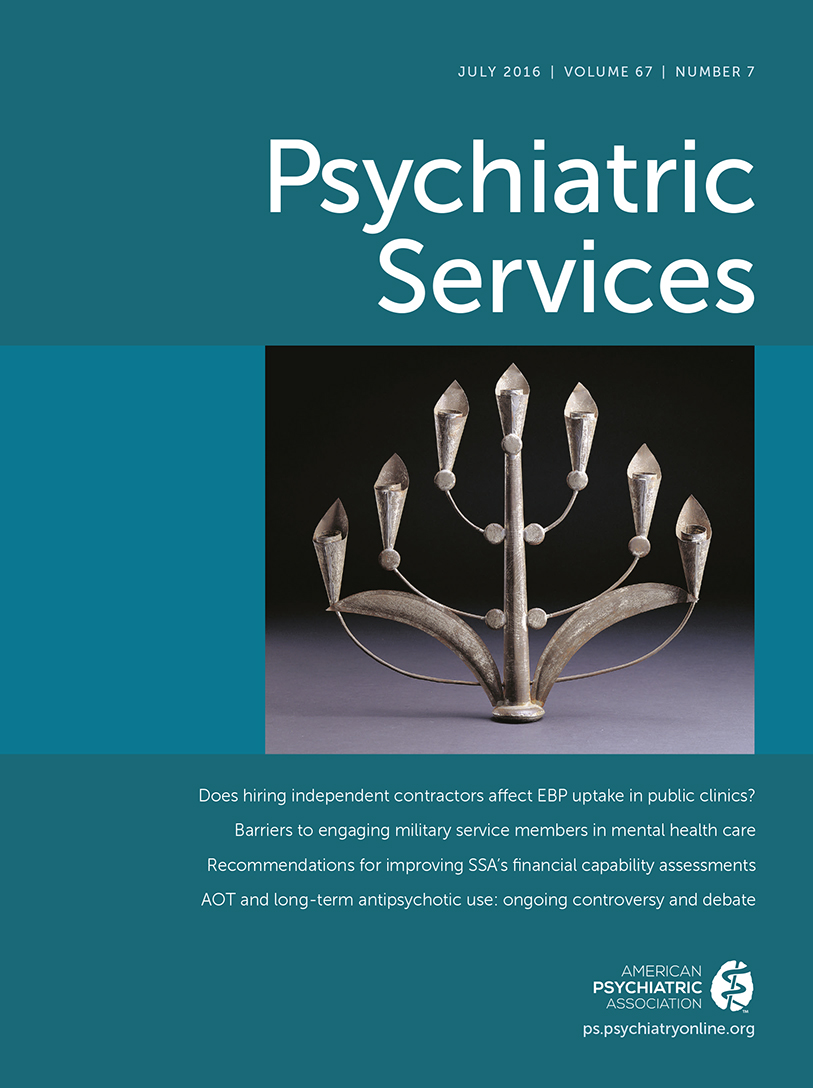AOT and Long-Term Use of Antipsychotics—2
TO THE EDITOR: In their Open Forum, Dr. Barnes and Dr. Badre (1) argued that recent data cast doubt on the efficacy of long-term (more than one to two years) use of antipsychotics and that “involuntary use of long-term antipsychotic treatment for relapse prevention for an asymptomatic patient with severe mental illness is rarely justifiable.”
The authors raise important clinical and ethical questions and rightly point to significant gaps in the research literature. However, we believe that they have conflated two distinct issues; first, the involuntary but usually short-term use of antipsychotics for high-risk individuals enrolled in assisted outpatient treatment (AOT) programs, and second, the risk-benefit ratio of long-term (more than one year) antipsychotic treatment (LTAT) for persons with schizophrenia. (Persons who experience a single episode of a psychotic illness may not have schizophrenia and may not require LTAT). Moreover, the “ethical and evidence-based treatment” Barnes and Badre rightly advocate must consider not only the patient’s autonomous wishes but also the long-term health and safety of the patient.
First, with respect to antipsychotic use in AOT programs, the duration of initial court-mandated outpatient treatment is generally brief. In 22 states, initial AOT orders are limited to 90 days or less; in 15 states, they are limited to 180 days or less (2). In New York State, 39% remain in the AOT program for no more than one year, and only 25% for more than 30 months (3). Thus, in New York State, a large percentage of AOT use of antipsychotics falls squarely within the relapse prevention period established in a study by Leucht and colleagues (4), in which antipsychotic drugs were significantly more effective than placebo in preventing relapse at seven to 12 months (relapse with drug, 27%; with placebo, 64%.)
Second, although long-term (more than one year) randomized controlled studies are lacking, several naturalistic and observational studies support the benefits of LTAT for persons with chronic schizophrenia. Ran and colleagues (5) carried out a 14-year prospective study of outcomes among people with schizophrenia (N=510) and compared the outcome of those who had never been treated with antipsychotic medication with that of patients who received medication. The investigators found that the rate of partial and complete remission among treated patients was significantly higher than the rate in the never-treated group—57.3% versus 29.8%. Moreover, the authors concluded that “never-treated/remaining untreated patients may have a poorer long-term outcome (for example, higher rates of death and homelessness) than treated patients.”
Indeed, there is considerable evidence that nonuse or discontinuation of LTAT carries substantial risk for persons with schizophrenia. Tiihonen and colleagues (6) conducted an observational study of antipsychotic treatment of patients with schizophrenia and schizoaffective disorder (N=2,230; average length of follow-up, 3.6 years). Excess mortality was seen mostly for patients not taking antipsychotic drugs for whom the risk of suicide was high. Similarly, Herings and Erkens (7) found a fourfold increased risk of suicide attempts among patients with schizophrenia who interrupted their use of second-generation antipsychotics.
Finally, although we lack randomized controlled studies of AOT with versus without an antipsychotic treatment arm—arguably, omitting a medication component would be unethical in this high-risk population—we have considerable evidence that AOT substantially reduces incarceration, arrests, psychiatric hospitalization, and homelessness (8). In sum, we find compelling reasons to continue including antipsychotic treatment as a component of comprehensive, periodically monitored AOT.
1 : Is the evidence strong enough to warrant long-term antipsychotic use in compulsory outpatient treatment? Psychiatric Services (Epub ahead of print, March 15, 2016)Link, Google Scholar
2 : Mental Health Commitment Laws: A Survey of the States. Arlington, Va, Treatment Advocacy Center, 2014. Available at tacreports.org/state-surveyGoogle Scholar
3 Program Statistics: Length of Time in AOT. Albany, New York State Office of Mental Health, 2016. Available at bi.omh.ny.gov/aot/statistics?p=time-in-aotGoogle Scholar
4 : Maintenance treatment with antipsychotic drugs for schizophrenia. Cochrane Database of Systematic Reviews 5:CD008016, 2012Medline, Google Scholar
5 : Different outcomes of never-treated and treated patients with schizophrenia: 14-year follow-up study in rural China. British Journal of Psychiatry 207:495–500, 2015Crossref, Medline, Google Scholar
6 : Effectiveness of antipsychotic treatments in a nationwide cohort of patients in community care after first hospitalisation due to schizophrenia and schizoaffective disorder: observational follow-up study. BMJ 333:224, 2006 Crossref, Medline, Google Scholar
7 : Increased suicide attempt rate among patients interrupting use of atypical antipsychotics. Pharmacoepidemiology and Drug Safety 12:423–424, 2003Crossref, Medline, Google Scholar
8 : An advocate’s observations on research concerning assisted outpatient treatment. Current Psychiatry Reports 16:435–441, 2014Crossref, Medline, Google Scholar



